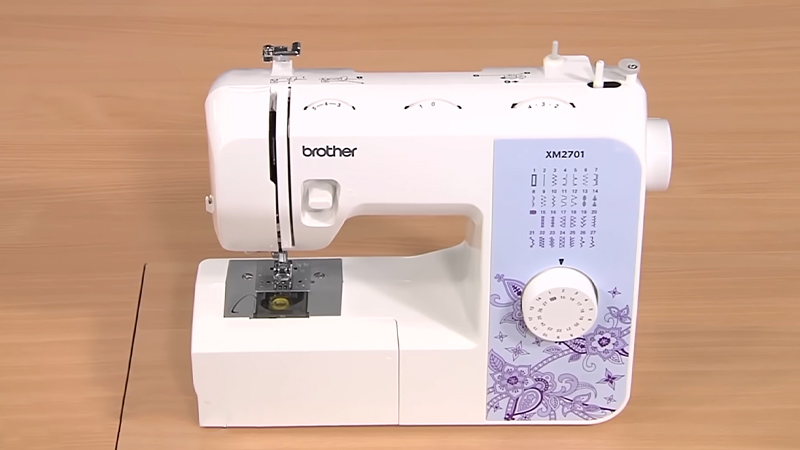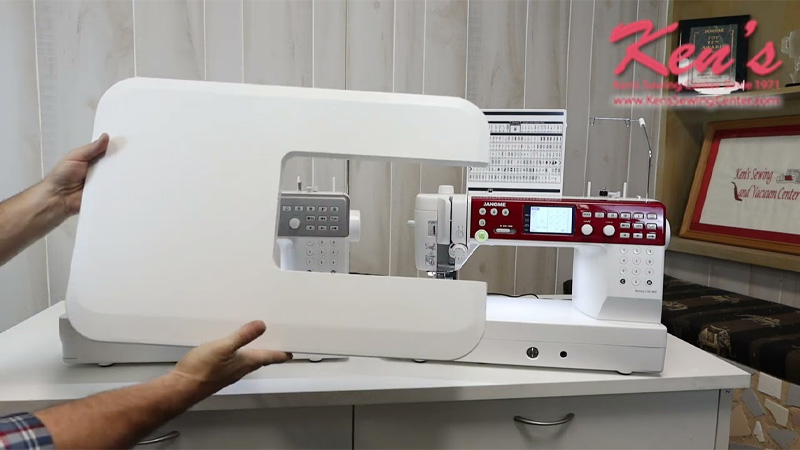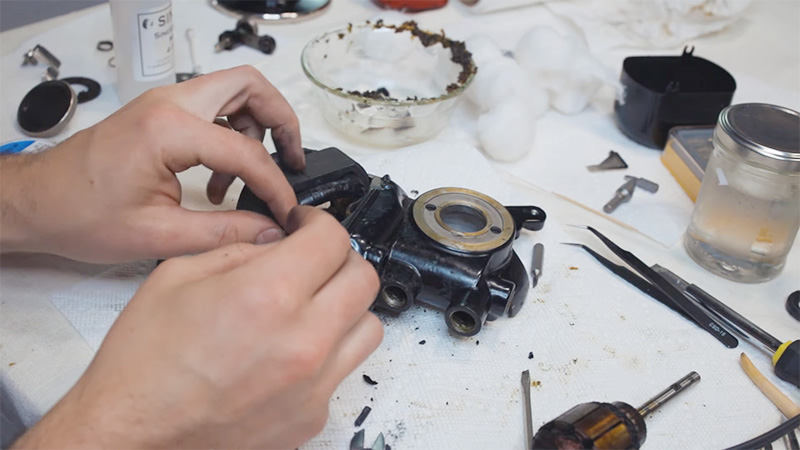Sewing machine frames are typically constructed from a variety of materials, each chosen for its unique blend of strength, durability, and affordability.
Commonly used materials for sewing machine frames include cast iron, steel, and aluminum. Cast iron frames offer unparalleled stability and longevity, making them a preferred choice for heavy-duty industrial machines.
Steel frames strike a balance between durability and weight, ideal for home sewing machines.
Meanwhile, aluminum frames are lightweight and corrosion-resistant, suitable for portable and modern computerized sewing machines.
The choice of frame material ultimately impacts a sewing machine’s performance, making it a crucial consideration for sewists of all levels.

What Are Sewing Machine Frames Made Of?
Sewing machine frames are the structural foundation of sewing machines, providing stability and support for the intricate mechanisms that enable precise stitching.
The materials used in constructing these frames are pivotal in determining a sewing machine’s durability, weight, and overall performance. Several materials are commonly employed:
Cast Iron
Renowned for its robustness, cast iron frames are often utilized in heavy-duty industrial sewing machines.
They offer exceptional stability, vibration dampening, and longevity. However, they tend to be heavier and less portable than other options.
Steel
Steel frames strike a balance between strength and weight. They are commonly found in home sewing machines, offering durability while still allowing for some portability. Steel-framed machines are well-suited for a wide range of sewing tasks.
Aluminum
Lightweight and corrosion-resistant, aluminum frames are favored for modern, portable sewing machines.
They are ideal for sewists on the go and those who require versatility in their sewing projects.
Plastic
Some budget-friendly sewing machines feature frames made from various types of plastics. While lightweight and inexpensive, these frames may not offer the same level of long-term durability as metal options, especially for heavy use.
How to Choose the Right Frame Material

Choosing the right frame material for your sewing machine is crucial to ensure that it meets your specific needs and preferences.
Here’s a step-by-step guide on how to make this decision:
Consider Your Sewing Needs
Start by assessing your sewing requirements. Are you a professional seamstress working on heavy fabrics and large projects, or a hobbyist focusing on lightweight materials and occasional sewing? Your sewing tasks and frequency will influence your frame material choice.
Evaluate Portability
Determine whether portability is a priority for you. If you need a machine you can easily transport to sewing classes or other locations, lightweight materials like aluminum may be more suitable. However, if your machine will stay in one place, a heavier, sturdier frame might be acceptable.
Budget Considerations
Your budget plays a significant role in frame material selection. Cast iron frames, while durable, tend to be more expensive. Steel and aluminum options are often more budget-friendly.
Noise and Vibration
Consider your tolerance for noise and vibration. Cast iron frames are excellent at dampening vibrations, resulting in quieter operation. If noise is a concern, this might influence your choice.
Durability and Longevity
Think about the longevity you desire from your sewing machine. Cast iron frames are known for their durability and can last for generations, while other materials may wear down over time.
Weight Capacity
When you plan to work on heavy fabrics or quilting projects, a frame with a higher weight capacity is crucial. Cast iron or steel frames can handle more substantial materials.
Environmental Impact
When you are environmentally conscious, consider sewing machines with frames made from sustainable or recycled materials to reduce your carbon footprint.
Test the Feel
Whenever possible, visit a sewing machine store and physically try out machines with different frame materials. This hands-on experience will give you a better sense of how each material feels in use.
Read Reviews and Seek Recommendations
Research sewing machine brands and models that use the frame material you’re interested in. Read customer reviews and seek recommendations from experienced sewists to learn about real-world performance and durability.
Consult with Experts
If you’re unsure about which frame material is best for your specific needs, don’t hesitate to consult with sewing machine experts or professionals who can provide valuable insights and guidance.
Parts of Old Sewing Machine

Old sewing machines, particularly those from the late 19th and early 20th centuries, often have a distinctive design and a variety of parts.
Here are some common parts you might find on an old sewing machine:
Base or Cabinet
The base or cabinet is the sturdy wooden or metal structure that supports the sewing machine. In some cases, it can also serve as a storage space for sewing supplies.
Treadle
Many antique sewing machines are operated using a treadle, which is a foot pedal. Pressing the treadle with your foot powers the machine, causing the needle to move up and down.
Handwheel
The handwheel is usually located on the right side of the sewing machine. It allows you to manually move the needle and take control of the stitching process.
Needle
The needle is the crucial component that pierces the fabric to create stitches. In older machines, needles were often changed by removing a clamp or thumb screw.
Presser Foot
The presser foot holds the fabric in place while sewing and can be raised and lowered using a lever. Different presser feet may be used for various sewing techniques.
Thread Tensioner
This mechanism controls the tension of the upper thread. Adjusting the tension ensures that stitches are even and well-formed.
Bobbin Case
The bobbin case houses the lower thread (bobbin thread) and is usually located beneath the needle plate.
Bobbin Winder
An old sewing machine may have a built-in bobbin winder, allowing you to wind thread onto a bobbin for the lower thread.
Needle Plate
The needle plate is a metal or plastic plate that covers the bobbin area. It usually has markings to guide fabric alignment.
Feed Dogs
Feed dogs are small, toothed mechanisms beneath the needle plate that move in a back-and-forth motion. They help feed the fabric through the machine evenly.
Stitch Selector
Some vintage sewing machines have a stitch selector or pattern dial that allows you to choose different stitch types and lengths.
Tension Release Lever
This lever allows you to release the tension on the upper thread, making it easier to pull the fabric out of the machine.
Reverse Lever
A reverse lever is often present, allowing you to sew stitches in reverse for backstitching to secure seams.
Thread Cutter
Many older sewing machines have a built-in thread cutter, which is a small blade used to trim the thread after sewing.
Accessories Compartment
Some vintage sewing machines come with a built-in compartment to store needles, bobbins, and other sewing essentials.
FAQS
Do different frame materials affect the noise level of sewing machines?
Yes, sewing machines with metal frames, such as cast iron, tend to be quieter due to their superior vibration-dampening properties compared to machines with plastic frames.
What is the most expensive sewing machine available on the market?
The most expensive sewing machines can cost several thousand dollars and are often high-end, computerized models from brands like Bernina, Husqvarna Viking, and Pfaff. These machines offer advanced features, precision, and durability.
What features define a modern sewing machine?
Modern sewing machines are equipped with features such as computerized controls, LCD screens, automatic needle threading, and multiple stitch options, and often include programmable embroidery capabilities.
Is there a sewing machine that makes metal frames?
Industrial sewing machines equipped with heavy-duty capabilities can be used to sew and join metal components for various applications like sewing metal eyelets onto fabric or working with leather, which sometimes includes metal elements.
Are there any special care or maintenance considerations for sewing machine frames made of specific materials?
Yes, some frame materials may require specific care routines. For example, cast iron frames may need occasional rust-prevention measures, while aluminum frames may benefit from regular cleaning to prevent corrosion. Refer to your machine’s manual for guidance.
To Recap
The choice of materials for sewing machine frames plays a pivotal role in shaping the performance, durability, and versatility of these essential crafting tools.
Whether crafted from the robust cast iron for industrial power, the balanced strength of steel for everyday use, or the lightweight convenience of aluminum for portability, each material caters to distinct sewing needs.
The frame’s composition dictates not only the machine’s sturdiness but also its ability to dampen vibrations, ensuring precise stitching.
It underscores the importance of considering the intended use and personal preferences when selecting a sewing machine.
Ultimately, the material of the frame is a crucial factor that sewists should weigh carefully to make an informed choice for their sewing endeavors.
Leave a Reply